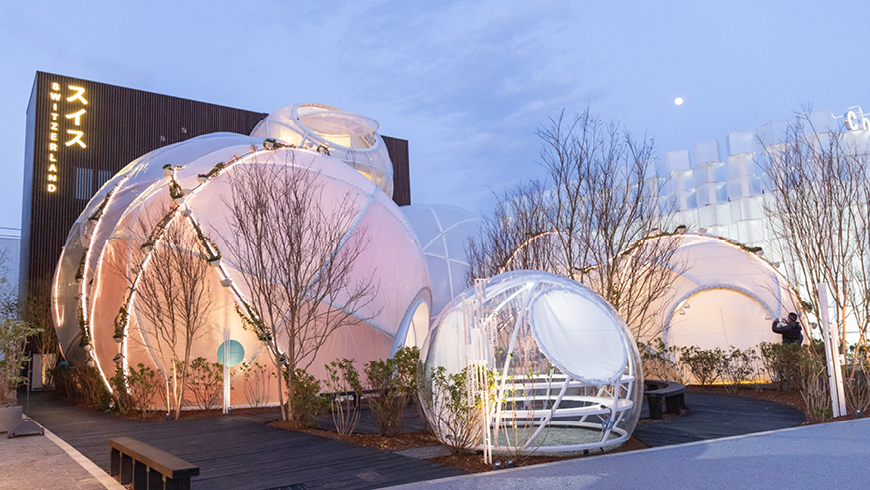A vision for a carbon-binding society
Empa's Mining the Atmosphere at the World Expo in Osaka
At the World Expo 2025 in Osaka, visitors of the Swiss Pavilion are invited to step into a future where carbon dioxide (CO₂) is no longer a harmful waste gas – but a valuable resource. Through animated videos and interactive lab samples, Empa unveils a bold vision: a world where CO₂ flows in endless cycles, powering clean industries and sustainable living. Running until 13 October, the PLANET exhibition has thus far attracted some 220'000 interested visitors. At the opening reception of the Swiss-Japan Energy Days at the Swiss Pavilion on 24 September, researchers from both countries, including Matthias Sulzer, member of Empa's Directorate, explored emerging trends in energy science, business and policy and expanded bilateral cooperation.

"Imagine our world, powered by clean energy, with all CO₂ flowing in cycles. A world where CO₂ becomes a resource, continuously reused, to tackle the climate crisis", this is the message that greets visitors of the Mining the Atmosphere exhibit, an immersive showcase of one of Empa’s flagship research initiatives. With more than 120 scientists collaborating across a wide range of disciplines, Empa's Mining the Atmosphere initiative is pioneering research into novel materials and technologies to capture, convert, and store CO₂ – transforming one of today's major climate gases into a precious resource for a truly sustainable future.
Materials that tell a story
A captivating video animation outlining the overall vision is accompanied by three intriguing material samples that visitors can touch and scan to unlock deeper insights. The first one is made of silica aerogel, a 3D-printed hexagon from the Empa labs representing cutting-edge research into novel materials for CO₂ capture. The center one is CO₂-negative concrete, highlighting the enormous potential of our built infrastructure to become tomorrow's permanent carbon sinks. And last, but not least, a Heidi plastic figurine as a Symbol of how everyday industrial processes and their feedstock can be de-fossilized using captured CO₂ – and a playful nod to Swiss-Japanese cross-cultural exchange. Each object serves as a gateway into the future of sustainable materials science – tangible proof of how innovation will reshape our relationship with carbon.
A glimpse into the future
Empa’s exhibit is a call to reimagine our world. By turning CO₂ from a climate threat into a valuable resource, Mining the Atmosphere is paving the way for CO₂-converting industries and carbon-binding societies worldwide. Visitors to the Swiss Pavilion are thus among the first to witness this transformative vision – where science, sustainability, and imagination converge.
Fittingly, on 24 September, the opening reception of this year's Swiss-Japan Energy Days took place at the Swiss Pavilion, where Empa's Matthias Sulzer, Member of the institute's Directorate and Head of the Department Engineering Sciences, presented the goals and the vision behind Mining the Atmosphere to invited guests. During the ensuing conference at Swissnex headquarters in Osaka, Sulzer was joined by ETH Zurich President Joël Mesot, Christian Schaffner, Executive Director of ETH's Energy Science Center (ESC) and Yasmine Calisesi, Executive Director of the EPFL Energy Center, among others, to rub shoulders with their Japanese colleagues and develop ideas about potential future cooperations. "The goal was to bring together top academic, industry and policy experts and breakthrough startups in order to spark future collaborations between Switzerland and Japan to drive energy innovation", says Felix Moesner, CEO of Swissnex in Japan and co-organizer of the conference.
Expanding Empa's partner network in Japan
During his trip to Japan, Sulzer also paid a visit to Empa's "sister institute", the National Institute for Materials Science (NIMS) in Tsukuba, where he was greeted by NIMS-President Kazuhiro Hono and the executives Masahiko Demura, Naito Masanobu, Kazuya Saito and Asuka Nio and discussed opportunities to deepen and further expand the already existing cooperations between the two institutes. "To strengthen our long-standing collaboration, we have jointly agreed to intensify the exchange of researchers, thus enabling us to benefit from each other's outstanding facilities and expertise", says Sulzer. "Together, we aim at propelling our work to the forefront of materials science – particularly in the fields of advanced additive manufacturing and analytics."
These visits highlight the important role of Japan as a cooperation partner for Empa. Just last May, Empa signed a cooperation agreement with Tohoku University's Advanced Institute for Materials Research (AIMR) to establish a new AIMR Joint Research Center (JRC) at Empa. Following the 2023 signing of a Memorandum of Understanding (MoU), Empa and Osaka University have since established a visiting scientist and student exchanges program to boost cooperation in the area of micro- and nano-joining, with regular visits taking place as recently as June 2025.
Prof. Matthias Sulzer
Department Engineering Sciences
Phone +41 58 765 47 29
-
Share






